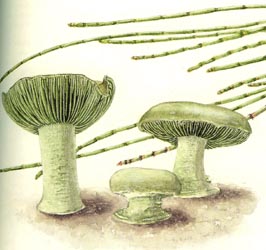[ Section Lepidella page. ]
[ Amanita Studies home. ]
[ Keys & Checklist/Picturebooks ]
[ Australia/New Zealand List ]
"Australian Virdigris Lepidella"

[See Australian Fungimap link, below, for additional image.]
Technical description (t.b.d.)
BRIEF DESCRIPTION: The following description is based on Miller (1992).
Amanita austroviridis occurs entirely buried in sand and the cap does not appear above the surface until the mushroom is well above maturity. The cap is 42 - 76 mm wide, olive-buff, broadly convex, planar or sometimes slightly depressed in the center, sometimes with margin flaring up in age, dry, not becoming tacky when moistened, with a nonstriate and appendiculate margin. The volva is present as numerous, small, flat patches tinted olive-buff to olivaceous-gray. The flesh is light green or light gray tinted olivaceous.
The gills are free or narrowly attached, green, drying dark green (close to the fresh color), very broad in age, with edges distinctly fimbriate. The short gills are present in at least two tiers, one tier extending half-way to stem.
The stem is 50 - 65 × 12 - 20 mm, expanding subabruptly to a turnip-shaped bulb, up to 30 - 33 mm. The surface is dry, buff with a faint olivaceous tint to olive buff. The lower part of the bulb is inserted in the substrate and tapers to a blunt base. The ring forms a fragile, flaring skirt near the gills or is present only as appressed scales on the top of the stem. The ring is striate on the upper surface and olive buff. The flesh is pale olive buff, sometimes discolored in the stem base, becoming dull olive in older specimens.
The odor is "stale and unpleasant."
The spores measure (9.2-) 10 - 12.6 × 5 - 6.7 µm and are ellipsoid to elongate to cylindric and amyloid. Clamps are probably present at bases of basidia, frequency is unknown.
Originally described from state of Western Australia in association with a shrub dominated community included, Eucalyptus (coastal jarrah), Agonis, Allocasuarina, Hakea, and Oxylobium.
Miller notes that the extraordinary green gill color remains bright "in dried material of all ages making it easier to recognize the dried specimens of A. austroviridis." Miller observes that the present species is assignable to subsection Solitaria within section Lepidella.
It seems possible to place A. austroviridis within Bas' (1969) stirps Grossa. It seems particularly similar to Amanita ochroterrea Gentilli ex Bas. This species is described as buff with dingy buff to dark buff gills. The form of the basal bulb of A. ochroterrea is very similar to that of A. austoviridis. The spores are also a very similar shape and size. In both cases the cap surface shows minimal gelatinization. [This is why moistening the cap of A. austroviridis does not make the cap tacky to the touch.] Both species have a weakly structured ring and both share a generally stocky appearance. Bas records that the volva remains completely cover the cap even at maturity in A. ochroterrea. This suggests that hyphal connection between the volva and the cap are never severed.
See also, Amanita chlorophylla A. E. Wood.
In the genus Amanita, elongate bulbs, narrow spores, and fruiting bodies deeply inserted in the soil are often associated with "leaky" ecosystems (Tulloss 2005).
The Australian Fungimap project link for this species is http://fungimap.rbg.vic.gov.au/fsp/sp051.html. -- R. E. Tulloss
Watercolor: Katrina Symes (Western Australia, Australia)
[ Section Lepidella page. ]
[ Amanita Studies home. ]
[ Keys & Checklist/Picturebooks ]
[ Australia/New Zealand List ]
Last change 6 October 2009.
This page is maintained by R. E. Tulloss.
Copyright 2002, 2003, 2004, 2005, 2009 by Rodham E. Tulloss.
Watercolor copyright 2009 by Katrina Symes.